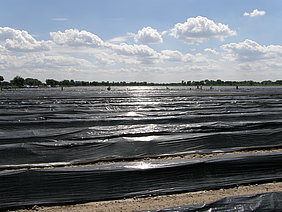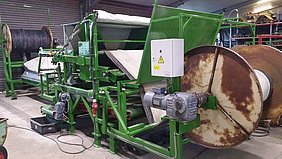A new process now allows to empty the side pockets of the plastic films commonly used in asparagus cultivation, which are filled with sand or soil, thus paving the way for an environmentally friendly recycling of the plastic materials. The process was developed as part of the R&D project "SpaFo".
In Germany, white asparagus is cultivated on more than 20 thousand hectares (ha). In order to simplify harvesting, reduce weed growth and water evaporation, and prevent green or purple discolouration of the asparagus spears through exposure to sunlight, the asparagus ridges are usually covered with black/white opaque PE plastic film during the harvesting season. To accelerate the growth of the spears at the beginning of the season, the black, light-absorbing side of the film is placed on top. When temperatures rise and the asparagus grows too fast, the film is turned to the white, light-reflecting side. Transparent film and film tunnels over the asparagus ridges are also used to speed up the growth of the asparagus shoots in spring. About 5000 running metres of film with a width of 1.4 metres are needed per hectare, totalling about 800 kg of plastic film. To prevent the plastic film from flying away in the wind, the films have pockets on the sides that are filled with sand or soil. After harvesting, the plastic sheeting is rolled up and stored temporarily until it can be reused. On average, the plastic sheets remain in use for eight years, after which they must be disposed for recycling. Bio-based, self-decomposing films are unsuitable as cover films because they do not offer such a long durability.
Until now, however, it has been a problem to recycle the no longer usable films. Because of the high proportion of sand in the film bags - the approximately 5,000 kg of sand or soil per hectare make up more than 80 percent of the total mass - the asparagus films have so far not been accepted by the recycling companies.
Scientists at the Potsdam Leibniz Institute of Agricultural Engineering and Bioeconomy (ATB) together with the mechanical engineering company HMF Hermeler GmbH in Füchtorf/Sassenberg have therefore developed a semi-stationary demonstrator. The machine unwinds the film, slits the pockets, then shakes the film vigorously and winds it up again. This allows more than 90 per cent of the filling to be removed from the bags. Instead of 5,800 kg of film and sand per hectare as before, only about 1,300 kg of slightly littered film now has to be transported to the recycling company. The process is considerably more cost-effective and valuable plastic can be recycled.
The studies also showed that this method leaves only very small amounts of microplastics in the sand shaken off, amounting to 0.017 g of plastic per kg of dry sand or 76 g per hectare every eight years. The collected sand can be used to refill new foil bags, for example, which further reduces the risk of an input into the soil.
The machine developed in the "SpaFo" project will in future be built and distributed by the project partner HMF GmbH. The first tests with farmers are scheduled for autumn 2023.
"We envisage that the machine, installed on a flatbed trailer, can travel from producer to producer in order to prepare the films for recycling on site. The advantage is that this work can easily be shifted to less labour-intensive times," says Dr Martin Geyer, "SpaFo" project manager and former head of the Horticultural Engineering Department at ATB. "Asparagus production without the use of films would be completely unprofitable in Germany and would significantly increase the cost of the vegetable," he adds. "The big advantages of the films are to accelerate or slow down the growth of the stems and to ease hand harvesting. Harvesting only has to be done once a day and yet the spears remain white. In addition, the films make herbicides unnecessary and they keep the soil moist for longer. Recent studies by the Leibniz Institute of Vegetable and Ornamental Crops (IGZ) have shown that there is more soil life under the films than in the uncovered soil."
The research and development project "Environmentally sound film disposal and avoidance of microplastics in asparagus cultivation" (SpaFo), coordinated by ATB, was funded by Landwirtschaftliche Rentenbank from the federal special-purpose fund (FKZ 912594) and was successfully completed after a period of two years at the end of 2022.
Contact:
Dr. Martin Geyer – Head of the "SpaFo" project
mgeyer@atb-potsdam.de
Ulrike Glaubitz - Presse- und Öffentlichkeitsarbeit
Tel.: 0331 5699-819/-820, presse@atb-potsdam.de
Das Leibniz-Institut für Agrartechnik und Bioökonomie e.V. (ATB) ist Pionier und Treiber der Bioökonomieforschung. Wir schaffen wissenschaftliche Grundlagen für die Transformation von Agrar-, Lebensmittel-, Industrie- und Energiesystemen in eine umfassende biobasierte Kreislaufwirtschaft. Wir entwickeln und integrieren Technik, Verfahren und Managementstrategien im Sinne konvergierender Technologien, um hochdiverse bioökonomische Produktionssysteme intelligent zu vernetzen und wissensbasiert, adaptiv und weitgehend automatisiert zu steuern. Wir forschen im Dialog mit der Gesellschaft – erkenntnismotiviert und anwendungsinspiriert. www.atb-potsdam.de


